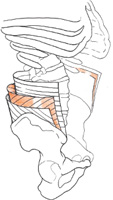Locating the Internal Obliques
Description
There is an internal oblique muscle on each side of the abdomen. Of the three broad muscles found on the sides of the waist, the internal obliques form the middle layer. They are situated under the external obliques and on top of the tranversus abdominis muscles.

The contractile (red) fibers of the internal obliques wrap the sides of the waist as they ascend from the pelvis to the rib cage.

Insertion
At its top, the internal oblique muscle attaches to the edge of the thoracic rib cage. At its bottom, it attaches to the iliac crest of the pelvis (the spot where you would put your hand on your hip) and extends along the inguinal ligament of the groin. At this lower level, the internal obliques have the longest and most significant fibers of all the broad muscles.
At the front of the abdomen, the aponeuroses of the right and left internal obliques meet at the linea alba, at the midline of the belly.
How the Internal Obliques Act on the Skeleton
1 • Side Bending and Forward Pelvic Rotation
An internal oblique can pull on the pelvis.
- It can pull the pelvis laterally toward the ribs (lateral inclination or side bending), and it can inhibit the movement of the pelvis in the opposite direction.
- It can rotate the pelvis forward, and it can inhibit its rotation in the opposite direction.

2 • Flattening the Rib Cage
An internal oblique can pull the front of the rib cage downward and toward the side of the pelvis, and it can inhibit its return to the starting position. The rib cage gets flatter and wider in this movement. (Note that when we drop the ribs like this we tend to exhale.)

3 • Indirectly Mobilizing the Vertebrae
By pulling the pelvis or rib cage laterally (to the side), an internal oblique can indirectly mobilize certain vertebrae, bending or rotating the spine at the waist, and inhibiting the spine’s movement in the opposite direction. It isn’t directly responsible for moving the spine, as it doesn’t attach to any vertebrae.

Situated obliquely at the sides of the trunk, the fibers of the internal obliques mobilize the sides on which they contract.
How the Internal Obliques Act on the Viscera
The internal obliques act in two particular regions of the belly.
1 • Compressing the Viscera above the Navel
The internal obliques exert a major action at their upper end (where the longest fibers terminate): when contracted, they press on the viscera principally above the navel, pushing them down toward the pelvis or out to the sides.

2 • Supporting the Lower Abdomen
The internal obliques have a specific and subtle action at their lower end, along the inguinal ligament, where their lower fibers are longest and most significant: when contracted, the muscles reinforce the inguinal ligament and contribute to supporting the lower abdomen.
The internal obliques can contract region by region. For example, they can contract strictly above the navel, at the level of the navel, or at the lower level where they border the pelvis. This means that we can pull in our belly in stages.

The internal obliques act on the viscera by tightening the belly, primarily in the area above the navel. They often act in conjunction with other abdominals.
